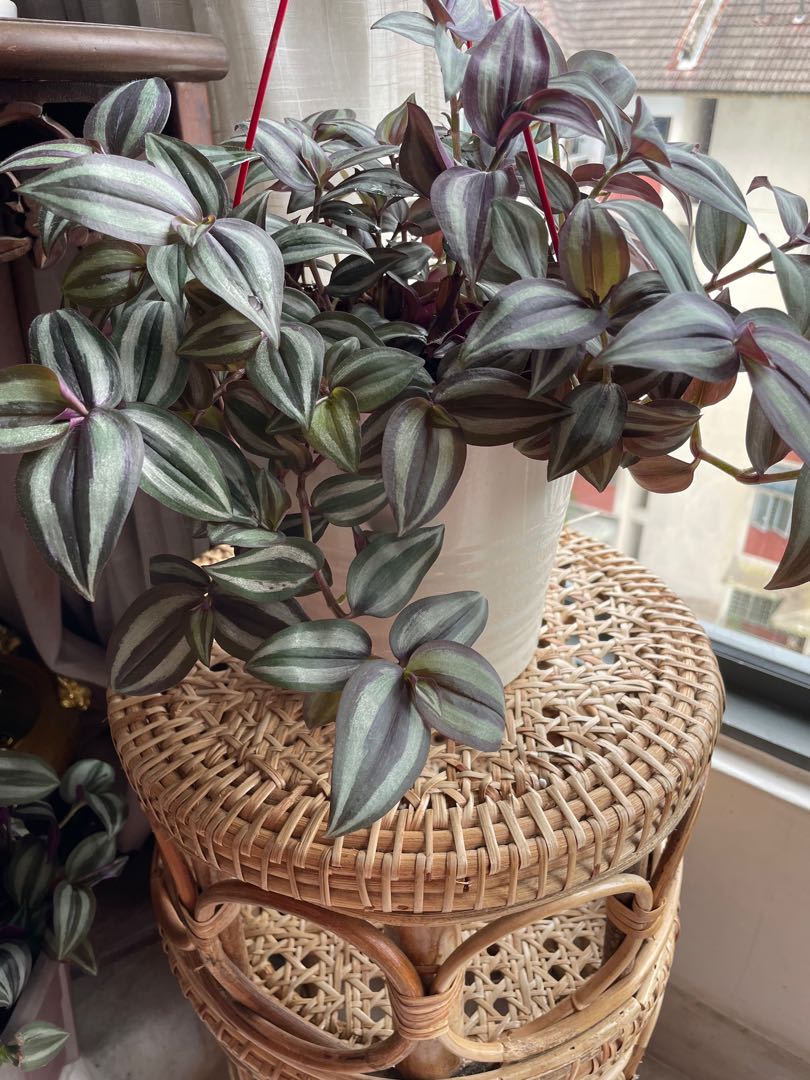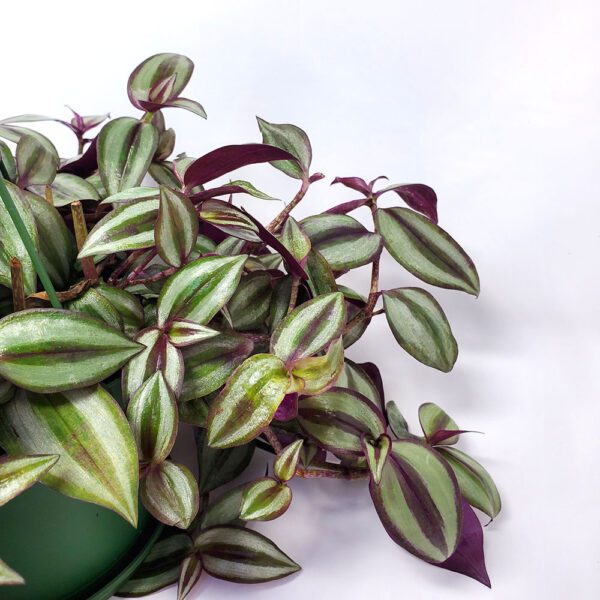Tradescantia is a versatile and attractive plant that has gained popularity among gardeners and indoor plant enthusiasts. Known for its vibrant foliage and easy care requirements, this plant can thrive in a variety of conditions, making it a great addition to any space. Whether you’re looking to enhance your garden or add some greenery to your home, Tradescantia offers both aesthetic appeal and practical benefits.
In this article, we’ll cover everything you need to know about Tradescantia, including its care, health benefits, and popular varieties.
Basics of Tradescantia
Botanical Name: Tradescantia spp.
Common Names: Spiderwort, purple spiderwort, Virginia spiderwort, common spiderwort, purple heart, wandering dude, trinity flower, inch plant, widow’s tears, oyster plant.
Origin: Native to North America, Central America, and South America
Zones: Most hardy types can be grown outdoors in USDA Zones 4-9. Tropical or semi-tropical species are hardy in Zones 9-12, depending on the variety.
Care Level: Easy
Light Requirements: Full sun to shade, depending on the variety. Houseplants prefer bright indirect light.
Growth Rate: Medium to fast, depending on the variety
Foliage: Hardy varieties produce strappy grass-like leaves in colors of green, blue-green, or gold. Tropical varieties have pointed or lance-shaped leaves with solid or variegated patterns in shades of green, white, silver, purple, pink, or cream.
Flowers: Three-petaled flowers 1/2 to 2 inches wide come in shades of white, purple, lavender, blue, or pink. The flowers on tropical species are insignificant compared to hardy outdoor species. Individual flowers last for a single day.
Bloom Time: Varies depending on the variety and growing conditions.
Habit and Size: Upright, spreading, or trailing habit; 3 to 36 inches tall, 9 to 24 inches wide
It’s important to note that Tradescantia is mildly to moderately toxic to pets and children. Contact with the sap can cause itching and skin irritation. Ingestion may cause stomach upset or other digestive issues. If necessary, contact your doctor, veterinarian, or local poison control.
Growing Tips for Tradescantia
Tradescantia is a forgiving and easy-to-grow plant, making it ideal for beginners. Here are some essential tips for growing this plant:
Where to Grow
Indoors, place Tradescantia near a window that receives bright indirect light. Outdoors, place it in a spot that receives full sun (with protection from afternoon sun in the hottest regions) to shade, depending on the variety. Indoor houseplants can be placed outside in a bright shady area during warmer months.
Temperature
Indoor houseplants prefer temperatures between 55-80 degrees, and no colder than 50 degrees.
Humidity
They also prefer higher humidity. During winter when indoor humidity levels are low, place plants on a tray filled with pebbles and water or use a room humidifier to increase humidity.
Soil Type
Garden plants prefer rich, well-draining soil with an acidic pH of 5.0-6.5. They are adaptable to average garden soil as long as they don’t dry out. For indoor houseplants, use a high-quality all-purpose potting soil.
Pot Requirements
Choose a pot that is slightly wider and deeper than the root ball. Make sure containers have good drainage to prevent root rot.
Propagation
Tradescantia is easy to propagate from stem cuttings, offsets, division, or seed. Place offsets or cuttings in water to root, or plant directly into soil. Divide hardy perennials every few years in spring or fall. Start seed indoors 8 weeks before transplanting outside.
Care and Maintenance of Tradescantia
Proper care and maintenance are crucial for the health and vitality of your Tradescantia plant. Here are some key aspects to consider:
Watering
Tradescantias prefer moist soil. Provide good drainage and avoid overwatering to prevent root rot. Underwatering can cause plant stress. Water plants when the soil surface is dry 1-2 inches deep.
Fertilizing
Fertilize houseplants monthly during the growing season with a balanced liquid fertilizer. For outdoor plants, apply a slow-release all-purpose fertilizer in early spring and mulch with a thin layer of compost.
Pruning
Trim back vining types if they become leggy to encourage a fuller habit. Hardy varieties may become untidy after flowering. Shear back by a third to reinvigorate and encourage late-season rebloom.
Repotting
If roots are circling the bottom of the pot or growing out of the drainage holes, it’s time to repot. Do this in spring when plants emerge from semi-dormancy. Remove the plant from the pot, taking care not to break the fragile stems, and gently tease out roots. Place in a new container that is 1 to 2 inches larger than the previous pot and use fresh soil. Water thoroughly and place in bright indirect light.
Pests
Indoor houseplant pests may include aphids, spider mites, thrips, scale, and fungus gnats. Rinse plants with water, dab affected areas with 70% rubbing alcohol, or use an insecticidal soap for severe infestations. Garden pests include aphids and slugs.
Popular Varieties of Tradescantia
There are numerous varieties of Tradescantia, each with unique characteristics and features. Some of the most popular ones include:
Purple Spiderwort
- Zones: 8-12
- Exposure: Part shade to shade
- Habit: Spreading trailing habit
- Size: 10 to 14 inches tall and wide
- Bloom Time: Plants may bloom sporadically year-round.
- Color: Purple foliage with gray-green highlights, hot pink undersides. Flowers are white or lavender.
New Vogue™ Feeling Flirty™
- Zones: 10-12, usually grown indoors or as an annual
- Exposure: Medium to bright light indoors, part shade outdoors
- Habit: Trailing habit
- Size: 2 to 4 inches tall, trails to 36 inches
- Bloom Time: Plants may bloom sporadically spring to fall when grown outdoors.
- Color: Pink and green striped foliage with purple underside
‘Webmaster’ Spiderwort
- Zones: 3-9
- Exposure: Part sun to sun
- Habit: Mounding habit
- Size: Up to 18 inches tall, 24 inches wide
- Bloom Time: Early to mid-summer
- Color: Green foliage with lilac-colored blooms
‘Nanouk’
- Zones: 10-12
- Exposure: Part shade to shade, or medium to bright indirect light indoors
- Habit: Low trailing habit
- Size: 3 to 6 inches tall, 12 to 24 inches wide
- Bloom Time: Spring to fall
- Color: Cream, green, and pink striped foliage with magenta-pink undersides. Flowers have white, yellow, and pink accents.
Purple Heart
- Zones: 8-11
- Exposure: Full sun to partial shade
- Habit: Trailing spreading habit
- Size: 1 to 2 feet tall and wide
- Bloom Time: Summer
- Color: Purple foliage, pink flowers
Inch Plant, small-leaf spiderwort
- Zones: 9-12
- Exposure: Full sun to partial shade, with protection from hot afternoon sun
- Habit: Spreading or trailing habit
- Size: 6 to 9 inches tall, 9 to 24 inches wide
- Bloom Time: Summer
- Color: Green foliage, white flowers
‘Tricolor’, syn. boat lily, oyster plant, Moses-in-the-Cradle
- Zones: 9-11
- Exposure: Full sun to partial shade, with protection from hot afternoon sun
- Habit: Upright habit
- Size: 6 to 12 inches tall, 12 to 24 inches wide
- Bloom Time: Flowers throughout the year
- Color: Pink and green foliage with magenta undersides; white flowers
Virginia Spiderwort, syn. common spiderwort, spider lily
- Zones: 4-9
- Exposure: Partial sun to shade
- Habit: Upright spreading habit
- Size: 18 to 36 inches tall, 12 to 18 inches wide
- Bloom Time: Spring to summer, with possible rebloom in fall
- Color: Green foliage, violet-blue flowers
‘Sweet Kate’, syn. ‘Blue and Gold’
- Zones: 4-9
- Exposure: Full sun to partial shade
- Habit: Upright spreading habit
- Size: 10 to 18 inches tall, 12 to 18 inches wide
- Bloom Time: Late spring to mid-summer
- Color: Gold foliage, purple flowers
Troubleshooting Common Issues
Despite being a hardy plant, Tradescantia can sometimes encounter issues that affect its health and appearance. Here are some common problems and solutions:
Indoor Houseplants
- Faded leaf color: Can indicate too much or too little light. Move plants to a better light source.
- Leaf scorch: Can indicate too much light. Move plants out of direct sunlight.
- Wilted or yellowing leaves, stunted growth, or mushy stems: Can be symptoms of overwatering, which can result in root rot and fungal diseases. Make sure pots have adequate drainage and reduce watering. Plants may need repotting in fresh soil.
- Brown leaf tips: Can be a response to low humidity. Place houseplants on a saucer filled with pebbles and water, or use a room humidifier to increase air moisture.
- Leaf curl: Can be an indication of several factors. Leaves that curl inward are a sign of underwatering. Leaves that curl outward can indicate overwatering or not enough light. Adjust growing conditions as needed.
- Brown mushy roots: Can be a sign of root rot from overwatering. Make sure plants have good drainage and don’t overwater. Cut out damaged roots and repot in fresh soil. In extreme cases, plants may need to be discarded.
Outdoor Plants
- Yellow or brown lesions on foliage: Can indicate rust, which is due to too much shade or poor air circulation. Move plants to a sunnier spot, thin plants, and reduce watering.
- Tan spots on leaves: Can be a sign of tan leaf spot, which is a virus affecting grassy plants. Remove affected leaves and discard in the garbage rather than compost pile to prevent spread of disease.
- Mottled pattern of green and yellow on leaves: May indicate mosaic virus. Remove affected leaves and discard in the garbage.
Display Ideas for Tradescantia
Tradescantia is not only beautiful but also versatile in terms of display. Here are some creative ideas to incorporate this plant into your space:
- Use a spreading type as a groundcover around shrubs or to quickly fill in bare spots.
- Plant a trailing variety in a hanging basket and display on a shady patio, deck, or porch during warmer months.
- Display a tropical vining type in a decorative hanging pot to dress up a kitchen or living room window.
- Adorn a bookshelf, dining or end table with an upright or trailing tropical variety.
- Group several Tradescantia together with foliage in different colors, sizes, and shapes on an indoor table or shelf for a tropical effect to lift your spirits during winter months.
- Add a living accent to a bathroom where your plant will benefit from the extra humidity.
- Mass a hardy variety near a pond, stream, bog, or other water feature for fine grassy texture and weeks of flower color.
- Place a small to medium-sized specimen in a colorful pot and display on your office desk to liven up your work environment.
- Mix a hardy variety with other moisture-loving plants such as astilbe, hosta, bee balm, and cardinal flower in a woodland border.
Health Benefits of Tradescantia

While Tradescantia is loved for its ornamental qualities, it also boasts a range of health benefits that have been valued since ancient times. Its leaves contain several active ingredients like flavonoids, organic acids, mucilages, and tannins, contributing to its healing power.
Anti-Cancer Properties
Studies show that the flavonoids in Tradescantia can help prevent tumor formation, making it an important plant in alternative medicine.
Detoxifying Effects
Tradescantia is effective in detoxifying the body and enhancing kidney function. Infusions of the plant, when combined with other ingredients like lemon, mint, and honey, can be used to combat the flu.
Digestive Health
The plant supports digestive health and is known to treat conditions like constipation, acting as a natural purgative.
Skin and Hair Care
Tradescantia doesn’t just benefit your insides—it also works wonders on your skin and hair:
– Skin health: Drinking Tradescantia tea can help maintain healthy skin and reduce the signs of aging.
– Hair care: The plant also moisturizes and cleanses the hair, ridding it of bacteria and germs. To use it, simply cut some pieces of the plant, leave them in a cool place for the day, and then apply the liquid to your hair. After a few minutes, rinse thoroughly with water.
Why You Should Have Tradescantia at Home
While Tradescantia is often seen as just a garden ornament, its health benefits make it a valuable addition to any home. Whether it’s improving your digestive system, detoxifying your body, preventing cancer, or enhancing the health of your skin and hair, this plant truly offers a range of benefits that make it worth having around.
So, if you don’t already have this beautiful and beneficial plant in your home, you may want to reconsider. Tradescantia is more than just a pretty plant—it’s a health treasure waiting to be discovered!
Author: [Nama Lengkap]
Title/Role: [Jabatan atau keahlian]
Credentials: [Ringkasan kualifikasi atau pengalaman terkait]
Profile Link: [Link profil, opsional]
Sources:
1. https://www.provenwinners.com
2. https://www.gardeningknowhow.com
3. https://www.hgtv.com
Internal Links:
1. 21 Best Indoor Plants
2. A Guide to Growing Peace Lily
3. A Guide to Growing Pothos
Call to Action: Stay updated with the latest news and trends in gardening and plant care. Explore today’s headlines and discover more about the beauty and benefits of Tradescantia.
URL Slug: everything-you-need-to-know-about-tradescantia-care-benefits-and-popular-varieties
Image Optimization:


Schema Markup:
{
"@context": "https://schema.org",
"@type": "Article",
"headline": "Everything You Need to Know About Tradescantia: Care, Benefits, and Popular Varieties",
"description": "Discover the care, benefits, and popular varieties of Tradescantia. Learn how to grow and maintain this versatile plant.",
"author": {
"@type": "Person",
"name": "[Nama Lengkap]"
},
"publisher": {
"@type": "Organization",
"name": "[Nama Situs]",
"logo": {
"@type": "ImageObject",
"url": "[Logo URL]"
}
},
"datePublished": "2023-04-05",
"dateModified": "2023-04-05"
}











More Stories
What Is Yodo Para Tiroides and How Does It Affect Thyroid Health?
How to Claim Your Joy in League of Legends: A Step-by-Step Guide
What is WSET? A Comprehensive Guide to Wine Education